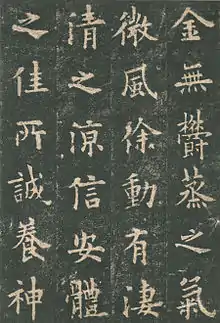Ouyang Xun
Ouyang Xun (Chinese: 歐陽詢; pinyin: Ōuyáng Xún; Wade–Giles: Ou-yang Hsun) (557–641), courtesy name Xinben (Chinese: 信本; pinyin: Xìn běn; Wade–Giles: Hsing-pên), was a Chinese calligrapher, politician, and writer of the early Tang Dynasty. He was born in Hunan, Changsha, to a family of government officials; and died in modern Anhui province.

Achievements
He was a talented student who read widely in the classics. He served under the Sui Dynasty in 611 as Imperial Doctor. He served under the Tang Dynasty as censor and scholar at the Hongwen Academy. There he taught calligraphy. He was a principal contributor to the Yiwen Leiju.
He became the Imperial Calligrapher and inscribed several major imperial steles. He was good at regular script and his most famous work is the Stele in the Jiucheng Palace. He was considered a cultured scholar and a government official. Along with Yu Shinan, Xue Ji, and Chu Suiliang he became known as one of the Four Great Calligraphers of the Early Tang.
He notably wrote the inscription of the Kaiyuan Tongbao cash coin which became one of the most influential coins in Chinese history,[1][2] this coin also influenced the calligraphic styles of other coinages in Japan,[3] Sogdia,[4][5] and Vietnam.[6]
Allusion in Literature
Ouyang was historically known for his legendary monkey-like ugliness and almost supernatural intellect.[7] These attributes were lampooned in an anonymous late 7th-century tale called “A Supplement to Jiang Zong’s Biography of a White Ape” (Bu Jiang Zong Baiyuan Zhuan, 補江總白猿傳). It tells how the beautiful young wife of General Ouyang He (歐陽紇, 538–570), Ouyang Xun's historical father, is kidnapped by a seemingly invisible force while he is engaged in conquering minority groups of the south lands. The general and his men scour the surrounding area for hundreds of miles before discovering a mountain where she and other women are being kept by a magic white ape (baiyuan, 白猿). The captives caution that his soldiers are no match for the powerful primate, and so the ladies devise a plan to get him drunk and incapacitate him long enough for a killing blow to be dealt. With their help, the general manages to fall the beast with a well-placed sword strike below the navel, his only weak spot. Before dying, the ape reveals the general's wife is pregnant and begs him not to kill the child. Ouyang subsequently returns to the north with his wife, the other women, and the monster's priceless treasures. The tale ends with the birth of an unnamed son a year later, thus implying Ouyang Xun was the unnatural offspring of the general's wife and the magic white ape.[8]
References
- "Chinese coins – 中國錢幣 § Tang Dynasty (618-907)". Gary Ashkenazy / גארי אשכנזי (Primaltrek – a journey through Chinese culture). 16 November 2016. Retrieved 9 June 2018.
- Hartill, David (September 22, 2005). Cast Chinese Coins. Trafford, United Kingdom: Trafford Publishing. ISBN 978-1412054669.
- Japan Mint History of Japanese Coins (for kids). Retrieved: 06 June 2018.
- "Samarqand's Cast Coinage of the Early 7th–Mid-8th Centuries AD: Assessment based on Chinese sources and numismatic evidence". Andrew Reinhard (Pocket Change – The blog of the American Numismatic Society). 12 August 2016. Retrieved 9 June 2018.
- "Soghdian Kai Yuans (lectured at the Dutch 1994-ONS meeting)". T.D. Yih and J. de Kreek (hosted on the Chinese Coinage Website). 1994. Retrieved 8 June 2018.
- The Asian Numismatic Museum (Sudokuone.com) Vietnamese Thien Tu and Kai Yuan Style - Thiên Tư Nguyên Bảo 天資元寶 Thư pháp, viết theo phong cách, Trung Quốc Kai Yuan by Dr. R. Allan Barker. Retrieved: 07 June 2018.
- Jue Chen, "A Supplement to Jiang Zong’s Biography of a White Ape," Renditions, 49 (1998): 77-78
- Chen, "A Supplement to Jiang Zong’s Biography of a White Ape," 80-85
- Wang, Jingxian, "Ouyang Xun". Encyclopedia of China (Arts Edition), 1st ed.
Bibliography
Jue Chen, "A Supplement to Jiang Zong’s Biography of a White Ape," Renditions, 49 (1998): 76–85.
External links
| Wikimedia Commons has media related to Ouyang Xun. |
- Gallery of Ouyang Xun at China Online Museum
- Resource Library Ouyang Xun — artnet.com.
- Yiwen Leiju "Collection of Various Matters from Classics and other Literature" — Chinaknowledge.de.
- Callygraphy during the Tang Dynasty Art Virtue
